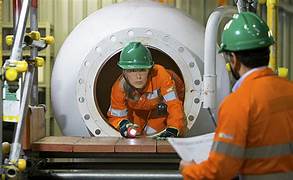Gas Atmosphere Testing: An Essential Aspect of Workplace Safety
In various industries, such as manufacturing, mining, and construction, the presence of potentially hazardous gases is a significant concern. Gas atmosphere testing is a crucial procedure employed to assess and monitor the air quality in work environments, ensuring the safety and well-being of workers. Understanding the methods and importance of gas atmosphere testing is imperative for creating a secure and healthy work environment. Let's delve deeper into the intricacies of gas atmosphere testing, its methodologies, and its indispensable role in workplace safety.
What is Gas Atmosphere Testing?
Gas atmosphere testing involves the systematic analysis and evaluation of the air composition within a particular workspace to identify the presence of harmful gases or vapors that may pose health risks to individuals exposed to them. This process aids in determining whether the air quality meets the required safety standards and guidelines established by regulatory bodies. By conducting regular gas atmosphere testing, employers can mitigate potential hazards and create a safe working environment conducive to employee well-being and productivity.
The Significance of Gas Atmosphere Testing in Various Industries
Gas atmosphere testing holds immense significance across a spectrum of industries, primarily due to the potential health hazards associated with exposure to certain gases. Understanding the importance of this testing procedure is crucial for ensuring workplace safety and preventing potential accidents or health complications. Some of the key industries where gas atmosphere testing is of utmost importance include:
Mining Industry: In mining operations, the presence of gases such as methane and carbon monoxide can pose severe risks to workers' health and safety. Regular gas atmosphere testing is essential to identify any hazardous gas build-up and implement necessary control measures to prevent accidents, explosions, or health-related complications.
Manufacturing Sector: Certain manufacturing processes involve the use of chemicals and gases that can be harmful if not properly monitored. Gas atmosphere testing helps ensure that the air quality remains within safe limits, thereby safeguarding workers from potential exposure to toxic fumes and vapors that could lead to respiratory problems or other health issues.
Construction Sites: Construction sites often involve activities that produce hazardous gases, such as welding fumes, carbon dioxide, and various volatile organic compounds. Conducting gas atmosphere testing on construction sites is crucial to prevent potential health risks and ensure that workers are not exposed to unsafe air conditions that could lead to accidents or long-term health complications.
Methods Employed in Gas Atmosphere Testing
Several methods and technologies are utilized in gas atmosphere testing to accurately assess and monitor air quality. These methods enable the detection of various gases and vapors, providing valuable insights into potential risks and facilitating the implementation of appropriate control measures. Some of the commonly employed methods in gas atmosphere testing include:
Direct-Reading Instruments: These portable devices are capable of providing real-time data on the presence and concentration of specific gases in the air. They are particularly useful for immediate on-site monitoring, allowing for quick responses to any sudden changes in gas levels and facilitating prompt preventive actions.
Colorimetric Tubes: These tubes contain specific reagents that change color in the presence of particular gases, thereby indicating the concentration of the target gas in the air. Colorimetric tubes are easy to use and provide a cost-effective method for conducting preliminary gas atmosphere testing in various work environments.
Gas Detectors and Sensors: Utilizing advanced technology, gas detectors, and sensors can detect and measure the concentration of multiple gases simultaneously. These devices are designed to provide accurate and reliable data, enabling continuous monitoring of the air quality in confined spaces and hazardous work environments.
Importance of Regular Gas Atmosphere Testing
Ensuring regular gas atmosphere testing is essential for maintaining a safe and healthy work environment. The significance of this practice extends beyond mere compliance with regulatory standards; it encompasses the overall well-being and safety of employees. Some of the key reasons highlighting the importance of regular gas atmosphere testing include:
Prevention of Health Risks: Regular gas atmosphere testing helps in identifying potential health hazards associated with exposure to toxic gases, enabling employers to implement preventive measures and safeguards to protect workers from adverse health effects.
Mitigation of Accidents and Emergencies: By monitoring the air quality and promptly identifying any abnormal gas levels, employers can effectively mitigate the risk of workplace accidents, such as fires, explosions, or chemical exposures, thus ensuring the safety of all individuals present in the work environment.
Compliance with Safety Regulations: Adhering to safety regulations and guidelines set by regulatory authorities is crucial for businesses operating in industries prone to gas-related hazards. Regular gas atmosphere testing ensures that companies remain compliant with the prescribed safety standards, thereby avoiding legal complications and potential penalties.
Promotion of Employee Well-being: Prioritizing the health and safety of employees fosters a positive work culture and boosts employee morale. Regular gas atmosphere testing demonstrates an organization's commitment to creating a safe and conducive work environment, thereby enhancing employee satisfaction and productivity.
Conclusion
Gas atmosphere testing plays a pivotal role in maintaining a safe and secure work environment across various industries. By employing effective testing methods and ensuring regular monitoring, employers can safeguard their workforce from potential health risks and prevent workplace accidents associated with hazardous gases. Understanding the significance of gas atmosphere testing and its methodologies is vital for promoting workplace safety, fostering a culture of health consciousness, and ensuring the overall well-being of employees. Embracing proactive measures to assess and manage gas concentrations in the workplace is essential for creating a sustainable and thriving work environment conducive to employee productivity and success. Some other courses that you need to provide for your employees include welding courses, scaffold training, rigging courses, etc.





Comments